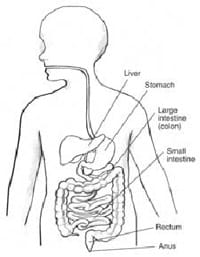What is Gastrointestinal Endoscopy?

Gastrointestinal (GI) endoscopy (commonly called a “scope”) is a special test that lets the doctor look at the lining of your child’s GI tract. An endoscope (in-doe-scope) is a long, thin, hollow tube with a special camera and light at the end. The doctor uses this camera to look at the GI tract. The parts of the GI tract your doctor can look at with the scope are the:
- Mouth
- Esophagus (e-sof-a-gus)
- Stomach
- Small intestine (in-test-in)
- Large intestine
Sometimes the doctor needs only to look at the upper part of the GI tract (esophagus, stomach and top of the small intestine). Sometimes the doctor may need only to look at the lower part of the GI tract (large intestine and lower part of the small intestine). Other times the doctor will need to look at both the upper and lower GI tract.




